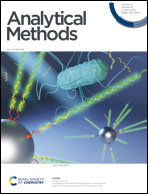A fluorescence-positioned hybridization chain reaction system for sensitive detection of Salmonella in milk†
Abstract
In this study, a fluorescence-positioned hybridization chain reaction (HCR) system for the detection of single-stranded DNA (ssDNA) specific to Salmonella was developed. Target ssDNA captured by magnetic beads was used to trigger the HCR, forming multiple double-stranded DNAs (dsDNAs). SYBR Green I was applied to intercalate with the minor groove of the dsDNA forming MBs + dsDNA + SYBR Green I. Magnetic separation was used to isolate the MBs + dsDNA + SYBR Green I from the excess reagents before recording the fluorescence intensity (FI). This fluorescence-positioned HCR method for the quantitative detection of Salmonella showed a limit of detection (LOD) as low as 4.2 × 101 CFU mL−1 in 0.01 M phosphate-buffered saline (PBS). When the method was applied in spiked milk samples, the LOD was recorded at 4.2 × 102 CFU mL−1. The fluorescence-positioned HCR method provided a modification-free and fluorescence-positioned strategy for sensitive detection of target DNA which holds promise for sensitive and selective bacterial detection.



 Please wait while we load your content...
Please wait while we load your content...